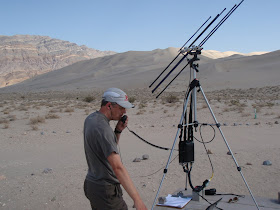
After the success of using solar power on the Death Valley trip last month (and indeed, using solar power for all my portable operations!), I've updated the solar system.
Solar Panels
I added another 20 Watt foldable solar panel (model F15-1200), so that brings the total panel capacity to 5+5+10+20 = 40 watts. Unfolded, the panels cover an area of about 6' by 3', and generate a nice amount of power in full sun.

LFP Battery
I also upgraded the battery from a 7 amp-hour Sealed Lead Acid (SLA) to a 6.4 amp-hour Lithium Iron Phosphate (LeFePO4) battery (model K2B12V7EB from K2 Energy). LFP batteries are very lightweight, have a high power capacity, and are very tolerant to high charge and discharge rates over many cycles. Tolerating a high charge rate is useful because it allows me to rapidly recharge the battery from the solar panels. In addition, LFP batteries are inherently very safe, and aren't prone to the thermal runaway of lithium-iron batteries. The "EB" version of this battery has a built-in battery management system (BMS) that prevents overcharge and overdischarge.

Charge Controller
Since the voltage specs on the LFP battery are similar to the SLA for max charge, I can use my exisiting SunForce 7-amp charge controller to prevent overvoltage conditions when using the solar array unattended. The controller cuts power from the solar panels when the system voltage reaches 14.2 volts. This is very important when running with a radio connected to the battery and solar panels -- without a charge controller, when the battery's BMS disconnects the battery at full charge, the full 18-21V from the panels could go direct to the radio! Using a charge controller makes sure the panels are disconnected at anything more than 14.2V.

Connectors
As usual, I put Anderson PowerPole connectors on everything (solar panels and battery). The connectors on the battery are fused with a 10A mini automotive fuse.

Weight and Portability
I'm especially happy with the weight of the system! The original SLA weighed almost 6 pounds alone. Since the new SLA weighs 2 pounds, and all four solar panels 3 pounds, the entire solar power system weighs less than the SLA alone. Plus, it has the clear benefit of rapidly recharging anywhere/anytime there's sunlight! Having ample power at reduced weight will be important when taking the radios hiking (as in terrestrial VHF/UHF contests from hilltops, etc).


In Use
Initial charging tests indicate that the LFP battery charges fully in just a few hours of bright sun. I measured the charge current at just over 2 amps, so in theory that should charge an empty batt in around three hours. Initial discharge tests indicate that the LFP will power a 60-watt light bulb through a 120V inverter for 1 hour -- the system draws around 6 amps in this test so that indicates at least 6 amp-hours of useable capacity. Since the FT-817ND radios draw 500mA on receive and 2.5A on transmit, 6 Ah actually translates to quite a bit of operating time! For satellite use, my 7 Ah battery will last for around a week of causual operating with the twin FT-817ND setup.













